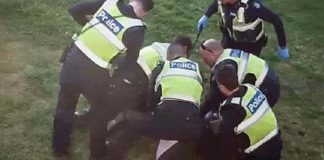Management at Sydney University has resorted to riot police, threats of student suspension and a ludicrous PR campaign to try and contain the anti-cuts campaign. But the campaign has put the Vice-Chancellor, Michael Spence, on the back foot.
On Monday May 7, over 600 students and staff marched up City Road to protest outside the Senate meeting. The protest coincided with 43 final letters being sent to staff—23 face forced redundancy, 20 face teaching-focused positions. When students moved to occupy the building, riot police summoned by the Vice-Chancellor ran amok—brutally head locking, dragging and throwing students to the ground. The Senate meeting was moved, but 150 students blockaded the re-convened meeting for over three hours.
The next day, 62 students attended the biggest ever Education Action Group (EAG) organising meeting. But some groups argued against a continuation of the militant tactics that have built the campaign so far, in favour of a festival. After a vigorous discussion, the meeting ended with a confused decision to hold both a partial strike and speak out and a festival on the same day. This compromise diluted the political importance of arguing clearly for a strike as the next step in the campaign.
Another EAG, two days later, agreed to build the two events separately, with the speak out and sit-in to be held on Wednesday May 23.

Victories
Mass actions and militant tactics have won concessions from the University. The number of academic redundancies has been drastically reduced, from 100 to 55, and teaching-focused positions have been reduced from 64 to 55. So much for management’s claims that their hands are tied!
But the fight is far from over. The 23 academics facing forced redundancies can lodge a claim to have their case reviewed. The campaign’s demand is that all the letters be rescinded.
The university still plans to cut 190 general staff jobs and $28 million of “non-staff expenditure”. Along with these cuts, the university’s plans include “curriculum reform, including withdrawing units of study”, i.e. course and subject cuts.
Crisis
The anti-cuts campaign has created a minor crisis for the university management. Michael Spence called Student Representative Council (SRC) officers to tell them that the university’s security budget is exhausted, and threatened to invoice the SRC for further security costs. He’s also threatening to suspend students.
He took the time to be interviewed for a fluff piece in the Sydney Morning Herald to bleat that he is not a “managerialist bastard”—but the facts speak for themselves.
Even the Dean of Arts Duncan Ivison (who defends the cuts), admitted to a Faculty of Arts Board meeting that, “The change-management process has had a negative effect on staff morale and a negative effect on the reputation of the University.” The cracks between the university management should give us encouragement to keep up the campaign.
From walkouts to strikes
Momentum has been building over the past weeks. On April 24, around 250 students walked out of their lectures to descend on management offices. But divisions over strategy have meant that, despite a unanimous EAG vote, only a small section of the EAG has been actively building to step up the action for some classes to actually strike.
Some people have argued not to call a strike unless we know the entire student body will participate. But smaller, partial strikes can lay the ground for department-wide or a campus-wide action. A department like English, which has vigorously fought the cuts and won substantial victories, could lead the way. Student action can also encourage staff to take industrial action.
The lack of clarity in the EAG has meant that we are now looking to build for a student walk out and possible strike early in second semester.
To keep up the pressure this semester, and build support for a possible strike, the EAG is holding a speak-out and sit-in on May 23. We can draw inspiration from the three-month long student strike in Quebec. At Sydney University in the 1970s, occupations and strikes won a Political Economy department.
We can make common cause with the staff and student fight at Australian National University (ANU) where 26 Music School staff have been sacked and told to re-apply for just 13 jobs.
With management on the back foot, we need to show them that we are in this fight to win.
Erima Dall





